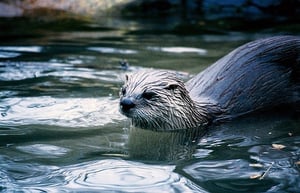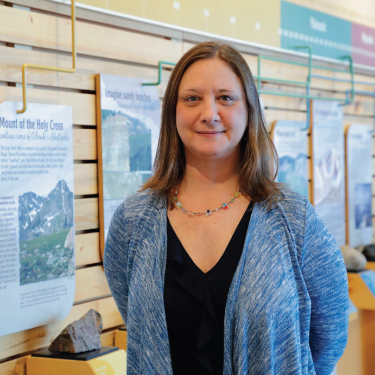 Wildlife sightings can be such fleeting experiences. My husband is much better at spotting animals than I am, and he often astounds me by pointing out bighorn sheep from the highway that are just a blur by the time I swivel my head around - and that’s when he’s driving. Years ago though, I had one of those momentary encounters while driving along the Eagle River south of Minturn that still sticks with me. I could swear I saw a river otter sliding along the rocks on the river bank. Good friends and longtime locals convinced me that otters didn’t live here and that I must have seen a beaver. I conceded, but the thought has always lingered that the long body that seemed to merge into a tapered tail did not look like any beaver I had ever seen.
Wildlife sightings can be such fleeting experiences. My husband is much better at spotting animals than I am, and he often astounds me by pointing out bighorn sheep from the highway that are just a blur by the time I swivel my head around - and that’s when he’s driving. Years ago though, I had one of those momentary encounters while driving along the Eagle River south of Minturn that still sticks with me. I could swear I saw a river otter sliding along the rocks on the river bank. Good friends and longtime locals convinced me that otters didn’t live here and that I must have seen a beaver. I conceded, but the thought has always lingered that the long body that seemed to merge into a tapered tail did not look like any beaver I had ever seen.
River otters are indeed rare in Colorado, and it is highly unlikely that I saw one along the Eagle River so close to the highway. The species is on the state’s list of threatened species, recently downgraded from endangered status. Population estimates, though, are extremely hard to come by for this elusive and solitary creature and the delisting was primarily based on the amount of habitat with otter sign. The last native otter in Colorado was documented in the early 1900s, the population decimated from the fur trade, habitat destruction and degradation, and a sparse population to start with. The Colorado Division of Wildlife (CDOW) began a reintroduction program in 1976 and introduced more than 100 river otters to various river systems in Colorado between 1976 and 1991.
The reintroduced otter populations are not exactly thriving, but river otter populations were never meant to thrive. These playful cousins to the weasel live fairly solitary lives, defending their territory from other members of the same sex and coming out mostly at night. Compared to other aquatic mammals, these carnivores are relatively big, usually 3-4 feet in total length. Their long flexible tails make up almost a third of their body length, and they use this and their flexible bodies to propel themselves while swimming. They can swim at up to 7 mph and stay underwater for about 4 minutes without coming up for air. The otter’s body shape, webbed feet and thick coat make them most comfortable in the water, but otters do occasionally travel on land, using a gait of running and sliding, especially over ice and snow. Otter monitoring after the reintroduction in Rocky Mountain National Park showed that some otters even traveled over high mountain passes, probably because the habitat was already saturated and they were in search of new territory.
Otter pups are born in late March or early April, and right about now, mama otters are probably busy nursing and caring for their young pups. River otters breed shortly after the females give birth, but the embryos undergo delayed implantation, waiting around for 9 months before beginning the 60-day gestation period. When the time is right, mama otters leave busy waterways and find a quiet pond where they den in an abandoned burrow or hollow log and give birth to 2-4 helpless pups. The pups around here are probably just now opening their eyes, at 3-4 weeks old, and most will be ready for their first swim by the end of the month. Although they will be fully weaned by about 10 weeks, the pups often stay with their family throughout the fall and sometimes for the winter.
So are there any otters around here? Believe it or not, CDOW has documented otter slides at the Gypsum Ponds, and local kayakers and rafters have spotted them out playing on the Upper Colorado and even the Eagle River. Of course, otters are often confused with other aquatic mammals, including beavers, muskrats, and mink, especially while swimming. They can usually be distinguished from these other animals by their large size and thick tail, but you have to get a good look. So if you are out there enjoying the spring runoff, keep your eyes peeled for a glimpse of that elongated form that tells you it’s not just a beaver.
Author Jaymee Squires is the Director of Graduate Studies at Walking Mountains Science Center. She lives in Eagle with her family where she loves to play outside and avidly works on her wildlife spotting skills.









